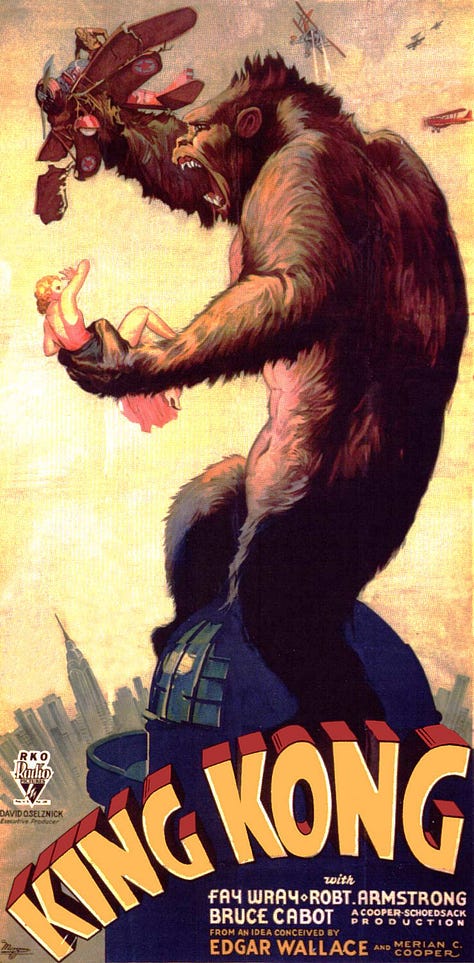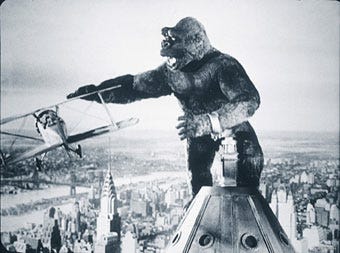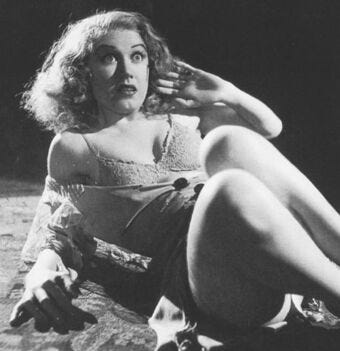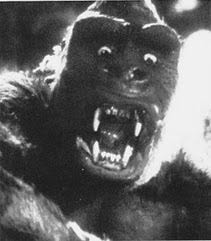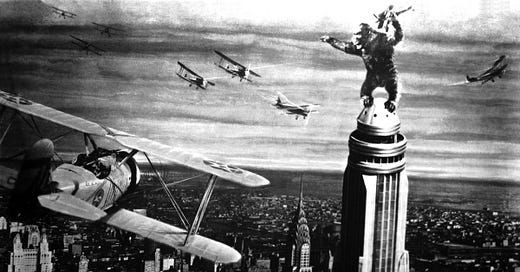KING KONG
1933 • Merian C. Cooper, Ernest B. SchoedsackScreenplay: James Creelman, Ruth Rose; Story by Edgar Wallace, Merian C. Cooper
Cast: Fay Wray, Robert Armstrong, Bruce Cabot, Frank Reicher, Sam Hardy, Victor Wong, James Flavin, Etta McDaniel, Everett Brown, Noble Johnson
Cinematography: Eddie Linden, Vernon Walker, J.O. Taylor
Music: Max Steiner
Producer: Merian C. Cooper, Ernest B. Schoedsack
RKO Radio Pictures
He's always been king of his world, but we'll teach him fear. We're millionaires, boys. I'll share it with all of you. Why, in a few months, it'll be up in lights on Broadway: Kong, the Eighth Wonder of the World.
A daring and unscrupulous filmmaker, Carl Denham travels to the mysterious Skull Island in the hopes of capturing an exotic creature to feature in his movie. Accompanied by a crew of adventurers and his leading lady, Ann Darrow, Denham discovers a land lost in time, teeming with prehistoric wonders and a tribe of natives who worship the colossal ape, Kong, as their deity. When Ann is captured by the awe-inspiring creature, Denham, along with the ship's first mate Jack Driscoll, launches a perilous rescue mission. As they navigate the island's treacherous terrain, encountering dinosaurs and other monstrous beings, the team manages to save Ann and captures Kong with the intention of displaying him as the "Eighth Wonder of the World" in New York City. However, chaos ensues when Kong escapes captivity in the city, unleashing his wrath and fascination with Ann upon the unsuspecting metropolis.
In the vast and ever-evolving landscape of cinema, few films have managed to leave an indelible mark on the industry quite like the 1933 classic, King Kong. This iconic masterpiece, directed by Merian C. Cooper and Ernest B. Schoedsack, seamlessly blends the elements of a monster movie and a love story, encapsulating a timeless narrative that continues to amaze audiences nearly nine decades after its debut. It doesn't strive to be an epic tale of heroism or an intricate mystery; instead, it is a straightforward yet deeply moving exploration of the age-old adage, "It was Beauty that killed the Beast." This simple yet profound statement encapsulates the film's essence, embodying the tragedy and beauty interwoven within its narrative.
What sets King Kong apart from its contemporaries and even modern films is its groundbreaking innovation. In the early 1930s, when cinema was still finding its footing, this film dared to pioneer the art of storytelling in ways never seen before. Its special effects, courtesy of Willis O'Brien's remarkable stop-motion animation, elevated the film to unprecedented heights. The meticulously crafted sequences featuring Kong's interactions with the human characters showcased a level of creativity and technical prowess that was simply unparalleled at the time.
Yet, when viewed through the lens of the 21st century, it's undeniable that the special effects of the 1933 version might appear primitive to modern eyes accustomed to the marvels of CGI. However, it is precisely this primitive charm that adds to the film's allure. Witnessing the artistry and dedication poured into every frame, one can't help but appreciate the sheer audacity of the filmmakers of that era. King Kong may lack the glossy visuals of contemporary blockbusters, but it compensates with heart, soul, and an unyielding spirit that has made it endure through generations.
There is a compelling interpretation of the film, that bears some examination. Some critics and scholars have found that Kong is a profound commentary on the very art of filmmaking itself. The story revolves around a filmmaker, Carl Denham, whose relentless pursuit of capturing the most sensational and extraordinary footage leads him to distant and exotic lands, including the dense jungles of Skull Island. Denham embodies the archetype of a filmmaker consumed by his vision, caring little for the cultures he may be infringing upon in his quest to immortalize the spectacle on film.
Denham is an artist driven by an unyielding passion for his craft. He symbolizes the industry's insatiable hunger for the next big spectacle, often at the expense of ethical considerations. This narrative element raises essential questions about the ethics of filmmaking: How far should filmmakers go in their pursuit of captivating stories and breathtaking visuals? At what point does artistic ambition cross the line into exploitation? Denham epitomizes a colonial mindset, where the exploration of foreign lands is seen through the lens of conquest and exploitation rather than genuine cultural understanding. Viewed through this lens, Kong becomes a powerful critique of the film industry's historical and, at times, ongoing exploitation of foreign locales and cultures. It prompts important discussions about cultural sensitivity, authenticity, and the need for respectful representation in filmmaking, urging filmmakers to approach their craft with empathy, understanding, and a commitment to ethical practices. Ironically, the filmmakers of Kong themselves could have used a little more cultural sensitivity in the questionable representation of the black island natives.
Some interpretations of King Kong view it as a commentary on the perceived "dangers" associated with relationships between individuals of different races. In the story, the relationship between Ann Darrow, a white woman, and Kong, a giant ape from a mysterious and exotic island, can be seen as a metaphorical representation of interracial relationships in the context of the societal attitudes prevalent during the film's era. The narrative unfolds as a tragic tale, with Kong's fascination and affection for Ann ultimately leading to his downfall. It can be viewed as a cautionary tale, echoing the prevailing societal belief of the era that such relationships were inherently perilous. In this context, the film can serve as a lens through which to explore the racial tensions and prejudices of the 1930s.
King Kong shattered records and became the biggest opening ever at that time. Its influence reverberated far beyond the confines of the box office. The film inspired a plethora of genre films, from the other giant ape film Mighty Joe Young to the spine-chilling Creature from the Black Lagoon, to the giant lizards of Jurassic Park; all owing a debt to the grandeur of King Kong.
Throughout the years, the legacy of King Kong has only grown stronger, giving rise to an array of sequels, remakes, and reboots. These adaptations range in quality, with filmmakers trying to reimagine the colossal ape's adventures in increasingly spectacular ways, with… mixed results. The film was followed by an inferior sequel in Son of a Kong, a crossover with the iconic Japanese monster in King Kong vs Godzilla, a film starring a robot Kong in King Kong Escapes, a 1976 remake starring Jeff Bridges and Jessica Lange, followed by a sequel in 1986, King Kong Lives. Peter Jackson directed a big-budget, Oscar-winning blockbuster remake in 2005 and the property was rebooted as part of Legendary Entertainment’s MonsterVerse in 2017 with Kong: Skull Island. His most recent outing was a rematch with Godzilla in 2021’s Godzilla vs Kong.
King Kong remains not just a film but a cultural touchstone, a testament to the boundless imagination of its creators, the ingenuity of special effects, and the power of storytelling. It's a reminder that even in the face of technological advancements, the heart and soul of a movie can transcend the limitations of its era.
Oh no, it wasn't the airplanes. It was beauty killed the beast.
Notoable Awards & Accomplishments
National Film Registry: Inducted in 1991
AFI's 100 Years...100 Movies – #43
AFI's 100 Years...100 Thrills – #12
Streaming: Not currently streaming
Digital Rental/Purchase: Available at major digital retailers
Physical Media: Available on Blu-Ray and DVD.
